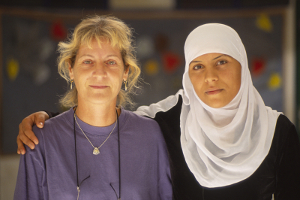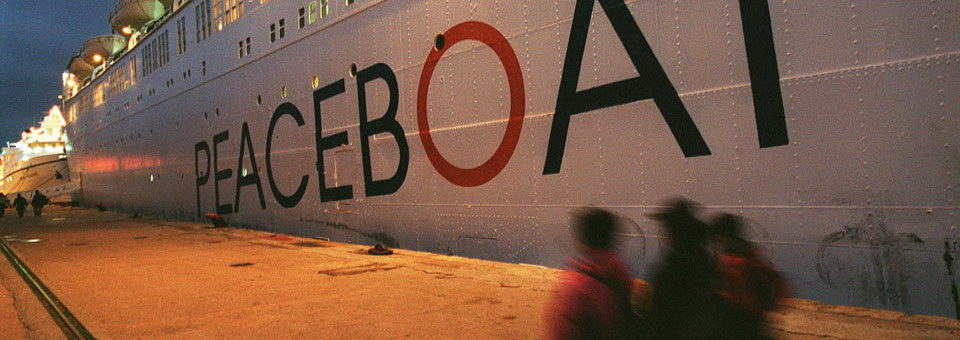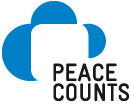Neve Shalom: School for Peace
 by Tilman Wörtz
by Tilman Wörtz
Photos: Frieder Blickle
In the jewish-arabic village Neve Shalom / Wahat al Salam people try to achieve the apparently impossible: living together in peace and sharing the power. So they founded their “School of Peace”, where young Jews and Palestinians learn how to talk to each other in a critical and fair manner.
The room measures seven by seven meters. Chairs for two dozen people are arranged in a circle. Windows just below the ceiling are blocked with curtains to keep out the searing Middle Eastern sun. It should not distract the young Palestinians and Israelis who will spend three days here talking, screaming, or sulking. Although they live in the same country, none of them had ever carried on a conversation with someone from “the other side” – not even about music or sports, let alone politics.
A two-way mirror allows moderators to observe how the relationship between the two groups alters over time without influencing their behavior. Meetings and conversations between individual young people that take place beyond the room’s confines – in the evening by the cabins, or during breaks at the coffee machine – are dismissed as “incidental noise,” without particular significance for the results of the encounter. The group dynamics inside the room are what counts.
The methods of the School for Peace in Neve Shalom enjoy worldwide respect as a benchmark in matters of conflict resolution. Groups from Cyprus, Kosovo, and Northern Ireland come here to get to know each other in this room. The school’s peace experts travel to universities in Tel Aviv, Jerusalem, Toronto and even Harvard to teach seminars there what is so new and promising about their approach.
Explaining the method is not entirely simple, because it runs counter to an everyday supposition. “Our feeling tells us that people just have to get to know each other, and then they’ll lose their hatred and prejudice,” says Nava Sonnenschein, founder of the School for Peace. “But understanding and sympathy for individual people can’t resolve conflicts between groups.”
At the School for Peace, groups are meant to argue – especially about painful topics. The dynamics of the conflict can be simulated in a small space. No one is obligated afterward to have found the other side “actually very nice.” Often enough, the emotional distance between the groups is greater after at departure than before their arrival. “But we still reach our goal,” Sonnenschein says. “The participants become conscious of their own roles in the conflict. They can no longer see themselves exclusively as victims.”
The first day is the day of wanting to be nice. The groups sit intermingled. Only a few Jews and Palestinians can be distinguished by their clothing: The quiet Daniel has drawn a star of David on the back of his hand. Dror wears faded jeans, with rings in her nose and navel. Rabab and Taher are all in white, their curls stabilized with gel as they would otherwise do only on special occasions.
A moderator explains the rules in Arabic: “Speak openly, but don’t insult anyone.” Then she translates into Hebrew, although all the Palestinians in the room understand Hebrew – the minority should enjoy equal status. The Palestinians are in 11th grade in Deir Hanah, an Arab village in the Galilee, where most of Israel’s Palestinian citizens live – one-fifth of the Israeli population. The Jewish kids are from the Renais-Casal School in Jerusalem, which has lost several students to suicide bombings.
They all laugh nervously and with a sense of relief as they talk about hobbies and school. It is determined that the Palestinians all seem to believe in God, while the Jews range from Orthodox to Atheist. Many Jewish parents allow their children’s lovers to sleep over, while even Palestinian boys allow their fathers to dictate when they come home in the evening.
After the ice is broken, the Jewish moderator tests the temperature in the room. “What should we call our group?” she asks. “Friends of Israel,” Anran suggests. He is 17, from Pisgat Zeev, a settlement in the West Bank. He looks forward to his military service, when he will protect his people from “killer Arabs.” He’s in Neve Shalom “to blow off steam.”
The Palestinians reject his suggestion. “We don’t identify with the name ‘Israel.’ Let’s be the ‘Friends of Peace.’” Dror likes the idea. She is 16 and thinks of herself as “politically left.” She likes rock music and nose rings, and she thinks Palestinians should have the same rights “as us Jews.”
“Why can’t you identify with the name ‘Israel’?” Anran insists. “Are you against the state? Do you want us to go away?” He throws Taher a ballpoint pen. “If that was a magic wand, what would you use it to wish for?” Taher says nothing, at least not aloud. “Come on!” The others join him in asking the Palestinians to take sides.
The moderator interrupts. “For one, it looks like the Palestinians are speaking nothing but Hebrew, and for two, the Jews are doing all the talking and demanding answers from the Palestinians.”
Hidden behind the mirror, Nava Sonnenschein smirks. “That was a good observation,” she says. “Details like that show you the power structure between the two groups. The Jews are stronger, just as they are in the state.” Sonnenschein is a teacher who served in the Yom Kippur war in 1973. She founded the school five years later. Too many of her friends died, she says.
She started work with conflict resolution methods tried and tested in the U.S. Participants expressed their feelings and tried to find commonalities. The ground rule was that feelings are not subject to debate – only to empathy. If a Jew said he was afraid of Arabs, she asked the Arabs to imagine his fear. Conversations about the roots of that fear, the conflict itself, were avoided.
“The Jews experienced the conversations as artificial. The Palestinians went home frustrated, because the reality of their oppression had not changed,” Sonnenschein remembers. Even when the meetings were harmonious, the effect was limited. “Our brain plays a trick on us – sub-typing. When you decide you like someone from the other side, you declare him an exception to the rule, and thus avoid readjusting your assessment of the total situation.” Nava Sonnenschein was in search of a new way to place dramatic emphasis on each person’s identity as part of a group.
Day two. The moderators lay out photographs in the middle of the circle. Each participants should give his interpretation of a photo. Anran chooses a picture of a soldier. “The army assures our security.” Dror selects a photo of two people swimming. “I see a Jew and a Palestinian, having fun together.” Rabab decides on a photo of a woman dressed in rags and carrying two plastic bags. “We are an impoverished people. Our land was stolen. We don’t have the same opportunities as Israelis. That has to change before there will be peace.” Rabab is 16, her slim body in western clothing. She wants to study psychology and came here because she would like to meet some Jews.
The moderators do not intervene when Rabab says “we” and makes herself the group’s spokesperson. That move allows the group dynamics to unfold. “How do you know the woman in the picture is an Arab? She could be Jewish,” Anran says. “You’re always feeling sorry for yourselves. Don’t always talk about the past. Look forward!”
Rabab snaps back, “You just showed up and took our land and made refugees out of hundreds of thousands of people.” The other Palestinians agree with her. Dror is silent. The others all talk at the same time, getting louder and eventually commencing what Nava Sonnenschein calls “the battle over the moral superiority of weapons.” The photos are forgotten; now the issue is which side wages a more brutal war: “As long as Palestinians blow up civilians, there will never be peace.” Answer: “The Israeli army kills civilians every day.” Defense: “Those are accidents, not deliberate.” One variation of the discussion is the question of who started the conflict and who has suffered more. The Jews point to the Holocaust and the Pogroms, the Palestinians to their refugee status and the occupation.
The mirrored wall seems to keep the tension in the room from affecting Nava Sonnenschein. She sits relaxed, leaned back in her chair, playing with her glasses. “The Palestinians feel stronger united behind Rabab. Her demands have made the Jewish group feel insecure, especially Dror. Anran evaded the discussion about land and stuck to the battle for the moral high ground.”
A book written by Nava Sonnenschein in collaboration with other researchers explains the escalation of conflicts between groups with two theories: The first says that conflicts arise through competition for scarce resources – in this case, land. The second theory, by contrast, assumes that group belonging is part of the identity of every human being, and that anyone can raise his self-esteem by cultivating hate and prejudice against others.
With the second theory, the prospects for a resolution of the conflict are significantly worse. It is rooted in human nature, not in distributive justice. One can only try to raise awareness of this psychological mechanism and thus reduce the potential for conflict – the main goal of the School for Peace.
Rabab’s reproach, that Israelis took the Palestinians’ land, was aimed at the competition for resources. With the discussion of whose methods of killing are more civilized, each group tried to diminish the other’s moral authority and legitimize its own violence. Accordingly, emotions climb as the noise level rises.
The moderators call for a break. The two groups recess for separate discussions. Desperation is palpable in the Jewish-Israeli group. “They have hate in their eyes,” Anran says, “and we have fear.” Even the “leftist” Dror is disappointed: “I’m trying to understand them. But why don’t they condemn the suicide bombers? It’s enough to make anybody radical!” Anet Schwab, whose grandparents were Holocaust survivors, says, “We can only survive if we’re strong.” The moderator poses questions: “You see yourselves in the weaker position. Don’t the Palestinians also have reasons to see themselves as victims?” The group disagrees strongly. They must feel strong to make the demands they make – for land, for repatriation in Israel, for an end to the occupation. “So they get humiliated at checkpoints! Who cares?” Anet bursts out.
“Dead end” is what the moderators call this stage of the discussion. Moderator Elenor stops Anet from going on. On her way to the teachers’ lounge, the tension almost has her crying. “I feel afraid every time that I won’t get the group past this point, and they’ll go home radicalized, that they’ll just feel powerless and angry without ever asking why.” Elenor Amit is 27, a psychology student with conservative parents. A session at Neve Shalom during her school days changed her outlook. With friends, she began organizing aid convoys with medicine into the West Bank.
Two decades of conflict resolution training have given Nava Sonnenschein a consistently Buddha-like smile. She calms Elenor Amit: “It’s at work inside them. Just wait.” Tomorrow, and again in three months, the pupils will be asked to write down their impressions. “The comparison regularly shows that the encounter is seen as more worthwhile in the second assessment.”
Even Dror’s statement offers something positive for Nava Sonnenschein: “When she says the encounter has radicalized her, then she’s finally admitting that her actual attitude toward the conflict collides with her claim to be ‘left.’ That will preoccupy her for a while.”
In a comparative study, the Israel Institute of Applied Social Research determined that the School for Peace was the most effective model for Jewish-Arab encounters. Over 26,000 people have taken part, of whom 400 went on to train as moderators and now work in peace projects in Israel and elsewhere.
When the group sits down again after the break, the taciturn Daniel sees that he is the only Jew seated on the right side. He gets up and crosses to a free spot. The two groups should now tackle the project of a new Israeli constitution. What should the national symbols be? What will be the rights of the Palestinian minority?
Thirty years ago, 20 Jewish and 20 Palestinian families sought an answer to that question. They founded the village of Neve Shalom/Wahat-al-Salam, halfway between Tel Aviv and Jerusalem. Since then they have proved that equitable coexistence between Jews and Palestinians is possible. Official communications are bilingual. Jews and Palestinians alternate control of City Hall. The elementary school is the only one in Israel with mixed classes. Both groups emphasize their ethnic identity, and neither goes out of its way to avoid conflict. In 1997, Tom Kitain of Neve Shalom, an Israeli army pilot, died in a helicopter accident on his way to Lebanon. His parents wanted to put up a monument. “He was going up there to kill our people,” the Palestinians protested. They agreed on a small plaque by the basketball court where Tom had often played with Arab friends: “In memory of a child of peace, killed by war.”
All over the world, “Circles of Friends” support Neve Shalom/Wahat-al-Salam. In Israel, opponents are more common. As if to spite the project, the Sharon government planned a settlement for army reservists just below it. A new school building promised by a prior government was blocked. Many Palestinian groups cannot obtain permission to travel to Neve Shalom. Their encounters are instead held in Turkey, Germany, or Cyprus. Some groups prefer to cross checkpoints on foot, finding taxis on the other side to take them to the next checkpoint. Then for three short days, they can feel safe on the neutral ground of Neve Shalom.
Before negotiations begin, the Palestinians decide to return to speaking Arabic and to rely on an interpreter. First order of business: What will happen with the 3.5 million Palestinian refugees who live outside Israel’s borders? “You can’t reasonably expect them all to be allowed back in!” insists even the “left” Dror. “Where are they supposed to live? In my pocket?” Rabab counters with the right of any Jew on earth to immigrate to Israel, even when he has never lived there. “It’s in the Bible,” says Mariana, the daughter of Russian immigrants, who is not religious. Anran stands and paces in a circle. The moderator asks him to sit down. “What do these negotiations have to do with me?” he asks defensively.
Again and again, the two groups retreat for private discussions, then come back to the negotiating table, until at last a simulated press conference announces the surprisingly liberal constitution of the new Israel: The official language is English, along with Hebrew and Arabic. The refugees can return to new settlements in desert areas. Palestinians can practice any profession, excepting the terror prevention wing of the police. Only the country’s name still remains open to debate.
For the final round, a rose and a branch from a thorn bush lie in the midst of the circle. They can be extended, separately or together, to anyone in the room. Dror gives both to Rabab: “The rose, because you talked with us, and the thorn, because you don’t condemn terror.” Rabab passes them on to Anran: “Because you’re good at heart, but you don’t listen.” Anran discards the thorn and gives the rose to Taher: “Because you kept your mouth shut.”

